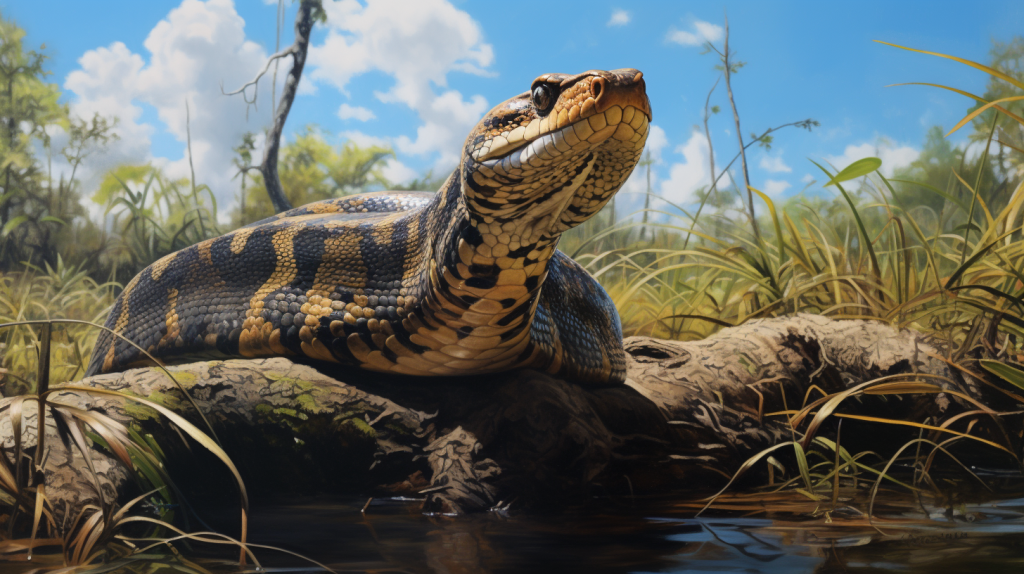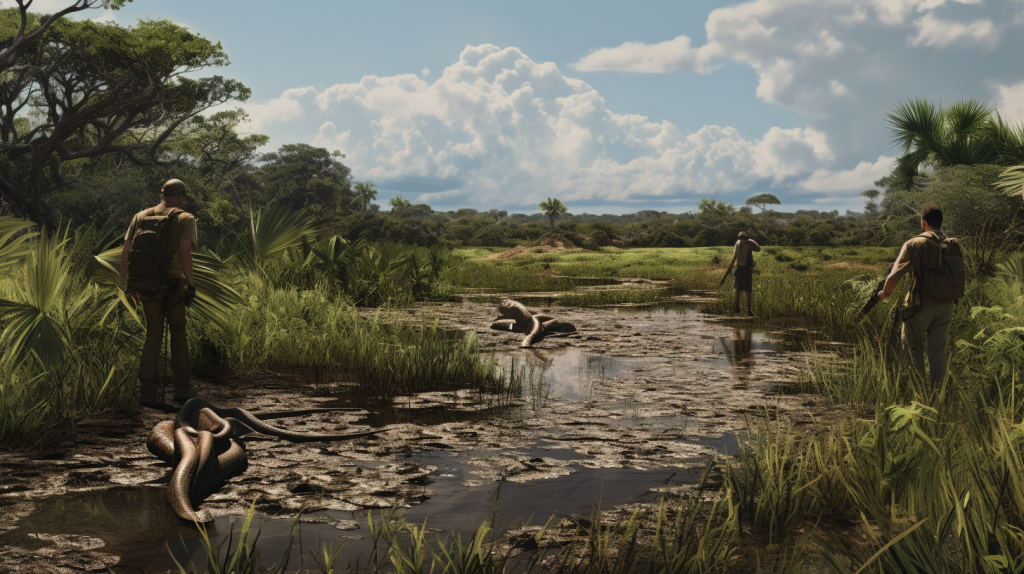Let’s delve into the mysterious world of a pythons in Florida map, that illustrates how these snakes have slithered their way into the heart of Florida’s landscape. These serpentine invaders have carved a unique niche for themselves, raising questions about the magnitude of the problem they present. As we navigate this perplexing situation, it’s worth considering the extent of their impact and the dangers that characterizes their presence.
Unraveling the Python Invasion: A Growing Predicament
Picture this: the mesmerizing expanse of the Florida Everglades, a haven for diverse wildlife. Now, imagine a new player in this delicate ecosystem – the python. Burmese pythons, once exotic pets, have become established invaders, sparking a dynamic ecological challenge. The scope of this problem is no small matter; it’s a complex puzzle that requires a closer look to understand its true dimensions.
The issue of the python invasion lies in the unexpected speed at which their population has grown. These invasive snakes have capitalized on Florida’s favorable climate, abundant prey, and lack of natural predators. Resulting in a population boom that defies conventional expectations. Their voracious appetite for native species disrupts the delicate balance of the Everglades, triggering ripple effects throughout the ecosystem. The sheer number of pythons, combined with their adaptability and elusive nature, compounds the challenge of managing their presence.
What Part Of Florida Has The Most Pythons?
As we map the spread of pythons in Florida, certain regions stand out as epicenters of their presence. While these invaders have made their mark across the state, the southern tip, including areas like Miami-Dade County and the Everglades, has been particularly affected. The result is evident in the concentration of python sightings and captures reported from these hotspots.
The tropical climate and extensive wetlands of South Florida create an ideal habitat for these adaptable reptiles. The dense vegetation, providing ample hiding spots and abundant prey, supports the rapid proliferation of pythons. The subtropical environment, marked by its unpredictable weather patterns and natural resources, contributes to the challenges of controlling their expansion.
How Far Up In Florida Are Pythons?
Picture this: the lush expanse of Florida’s landscape, where nature’s secrets unfold in bursts of discovery. Amidst this picturesque canvas, an unexpected invader, the Burmese python, is making its mark in the south. As we embark on a journey of exploration, tracking the python invasion’s northern expansion adds a layer of intrigue to their remarkable range. Multiplication is the key as we delve into the complexity of their spread, shedding light on the adaptability and resilience of these serpentine invaders.
Northward Bound: An Intriguing Expansion
In the tale of the python invasion, every movement holds a story of adaptation and survival. As we cast our gaze northward, a burst of curiosity emerges – how far have these invaders traveled? South Florida remains the epicenter of python activity, where their presence is a stark reminder of their successful establishment. But, reports echo tales of pythons venturing farther north, defying expectations and marking new territory.
Central Florida, a region synonymous with theme parks and orange groves, has witnessed the unexpected presence of these serpentine intruders. The regularity of these sightings underscores the adaptability of pythons, as they carve a path through diverse environments. This expansion continues to resonate beyond Central Florida, reaching areas previously untouched by their presence.
A Tale of Sporadic Encounters
The few python sightings in these northern regions paints a picture of sporadic encounters. Unlike the densely infested southern areas, where pythons seemingly lurk around every corner, the northern reaches experience sightings that are fewer and farther between. This unpredictability adds an element of mystery to their presence, as these elusive invaders navigate new landscapes.
Imagine the vastness of Florida’s northern expanses, where wetlands give way to upland habitats, and python encounters become bursts of surprise. The adaptability of these serpents allows them to thrive in this diversity of environments, a testament to their capacity to find opportunity in the face of change.
Predicting the Unpredictable
As the python invasion expands northward, sightings becomes a defining characteristic of their spread. The challenge lies not only in understanding the patterns of their movement but also in predicting the impact they might have on these new territories. The resilience of pythons and their knack for adapting to different habitats makes mitigating their influence an intricate puzzle.
What Eats Pythons In Florida?
Surprisingly, there are natural predators that contribute to controlling the python population, albeit to a limited extent. In the intricate tapestry of the Florida Everglades, where every creature plays a role in the symphony of life, an unexpected subplot unfolds – the occasional predation of Burmese pythons by native predators.
Alligators, with their prehistoric allure, and majestic birds of prey, such as eagles and hawks, occasionally cross paths with these invaders in a burst of ecological drama. Yet, as nature’s storylines often reveal, the intentions behind these interactions are shrouded in mystery, as the motivations of alligators or birds of prey targeting pythons remain a puzzle.
Imagine the scene: an alligator, an apex predator that has ruled the Everglades for eons, lurking in the water. Suddenly, it pounces, its powerful jaws clamping down on a Burmese python. Fighting takes center stage as the predator-prey dynamic takes an unexpected twist.
Similarly, a majestic eagle, the embodiment of freedom and grace, swoops down to seize a python in its talons. The intentions driving these interactions are as varied and enigmatic as the Everglades itself.
Conclusion: Pythons In Florida Map
In this dynamic landscape, a pythons in Florida map will help educate persons regarding the distance these predators have gone so far. Pythons have become a complex puzzle that intertwines their threat with ecological intricacies.
The extent of their impact is both perplexing and undeniable, as they adapt and thrive in the ever-changing environment of the Everglades. While their presence spreads across the map, their elusive nature and rapid growth make managing their invasion a unique challenge.
FAQs About Pythons In Florida Map
Q1: Are pythons native to Florida?
A: No, pythons are not native to Florida. They were introduced as exotic pets and have become invasive in the region.
Q2: Are pythons dangerous to humans?
A: While pythons are not generally considered a threat to humans, caution is advised when encountering them in the wild due to their size and strength.
Q3: How are authorities addressing the python invasion?
A: Authorities are implementing removal programs, hunts, and public awareness campaigns to manage the python population’s impact.
Q4: Can pythons survive in different habitats?
A: Yes, pythons are adaptable and can survive in various habitats, from wetlands to upland areas, contributing to their spread.
Q5: Are there efforts to prevent the introduction of pythons as pets?
A: Yes, organizations and authorities work to educate the public about responsible pet ownership and the risks associated with releasing pythons into the wild.
References:
- National Park Service. (n.d.). Burmese Python. https://www.nps.gov/ever/learn/nature/burmese-python.htm
- University of Florida IFAS Extension. (2022). Invasive Species: Burmese Pythons. https://edis.ifas.ufl.edu/uw392
- The Nature Conservancy. (n.d.). Pythons in Florida. https://www.nature.org/en-us/what-we-do/our-insights/perspectives/pythons-in-florida/
- Florida Fish and Wildlife Conservation Commission. (2022). Burmese Python. https://myfwc.com/wildlifehabitats/nonnatives/reptiles/burmese-python/
- United States Geological Survey. (n.d.). Burmese Pythons in Florida. https://www.usgs.gov/centers/wetland-and-aquatic-research-center-warc/science/burmese-pythons-florida?qt-science_center_objects=0#qt-science_center_objects





